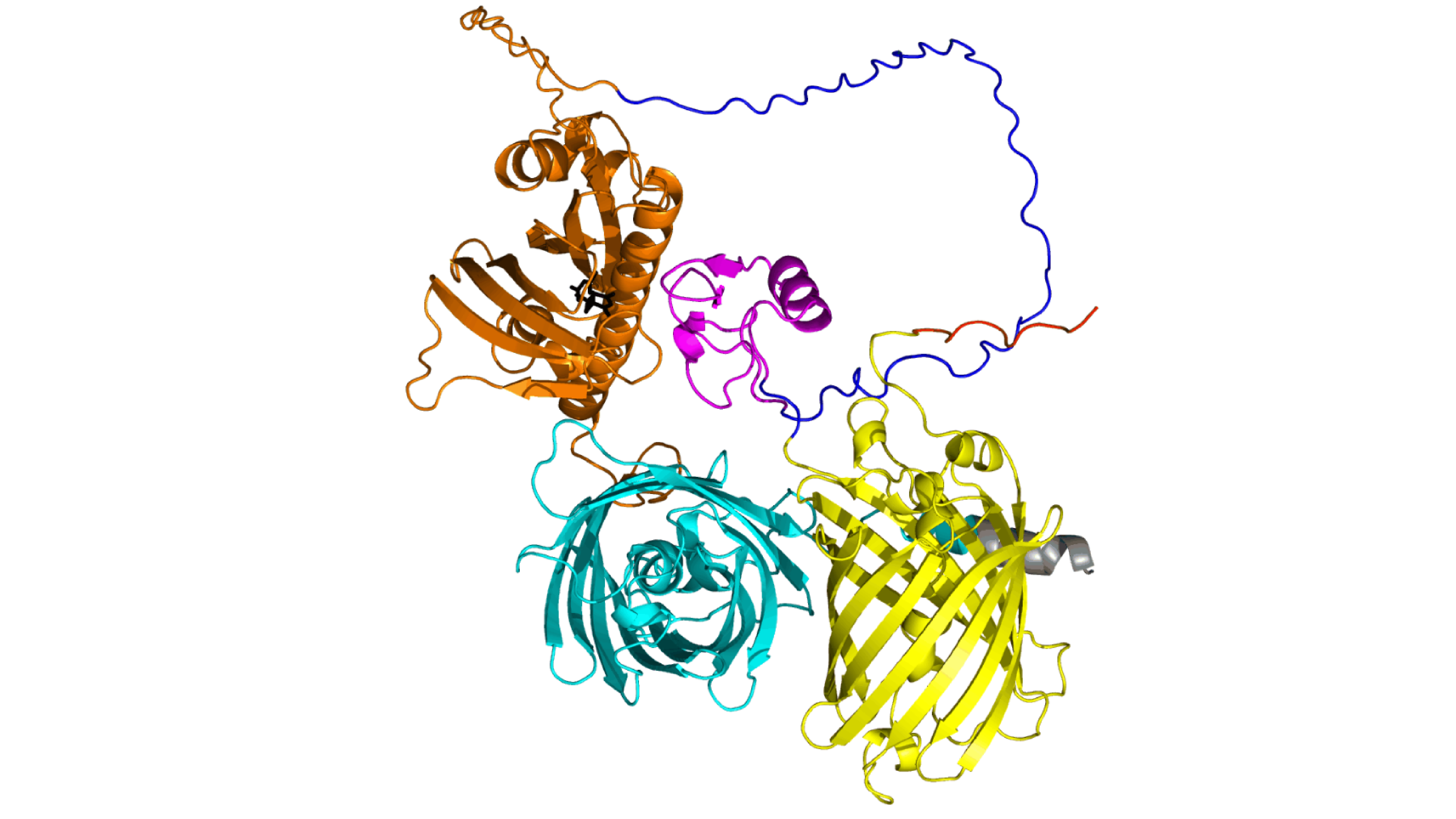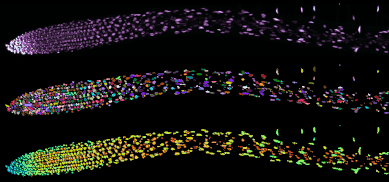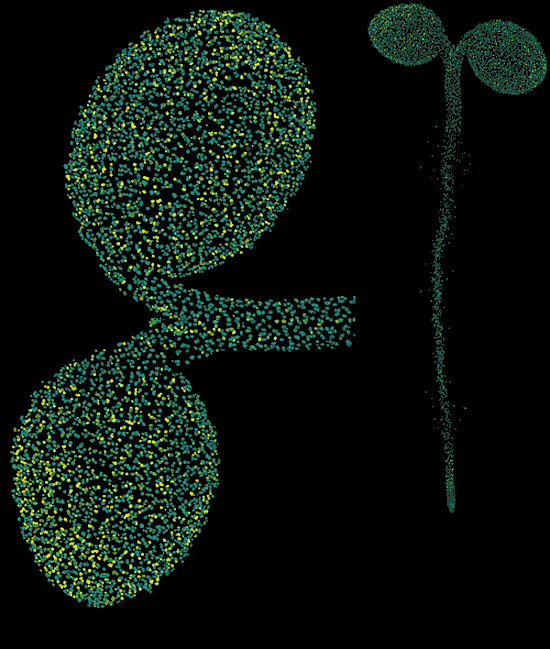
A protein structure model of the ABACUS2 biosensor made by the Jones lab to detect the plant hormone ABA.
Dry days trigger leaves to send a surprising growth signal telling roots to keep growing
Scientists at the Sainsbury Laboratory Cambridge University (SLCU) have discovered a new molecular signalling pathway, triggered when leaves are exposed to low humidity, that ensures plant roots keep growing towards water.
In dry soil conditions, plants take action to try and conserve water by producing the drought stress hormone abscisic acid (ABA). For decades plant scientists thought that in response to dry soil, ABA was made in the roots and then transported to the leaves. In this root-to-shoot signalling pathway, ABA closes microscopic leaf pores, called stomata, to prevent water loss from leaves. In recent years, scientists have shown that other root-to-shoot signals also tell leaves to make their own ABA to conserve water.
A new study has found that when the leaves of a plant are exposed to dry air (low humidity), they send a signal in the opposite direction to the plant’s roots – also using ABA – to tell them to keep growing. This is a surprising finding as ABA is usually thought to be a growth inhibitor, not a growth promoter.
This shoot-to-root signalling pathway potentially helps the plant to search for water deeper down into the soil, giving it a greater chance of survival.
Computer analysis of ABACUS2 helps the Jones group calculate the ABA levels in each cell. Each object represents a nucleus. Top: Original image, Middle: Computer identification of nuclei, Bottom: ABA levels. The colour tells you the ABA level. Blue: Low ABA, Red: High ABA. Images: James Rowe.
With the drought response now well documented in roots and not so much research done in shoot-to-root signalling, Dr Alexander Jones’ research team wanted to find out more about what was happening above-ground in the leaves under dry air conditions. The low humidity shoot-to-root signalling they discovered could be acting as an early warning for the plant to prepare for future water shortages.
The revelations, published in Nature Plants, were made possible through the Jones team’s design and re-engineering of a next-generation biosensor, ABACUS2.
Engineering biosensors to detect plant hormones in living plants at high resolutionAlexander Jones’ research group is developing in vivo biosensors that are revealing hormone dynamics in plants at unprecedented resolutions and, as a result, opening up new research directions. They create biosensing plants by modifying plant genomes to express a specialised biosensor protein that allows the scientists to see and measure a specific hormone when the biosensor binds to it. Co-author Mathieu Grangé-Guermente did much of the biosensor engineering work using brewer’s yeast (Saccharomyces cerevisiae) as a nano-factory to make improved variants of the original Abscisic Acid Concentration and Uptake Sensor 1 (ABACUS1). The resulting next-generation ABACUS2 biosensor is a FRET-based biosensor capable of detecting dynamic ABA levels in vitro, but also in plant cells, tissues and whole seedlings. This technology advance allows low ABA concentrations in individual cells of living plants to be quantified, including being able to track precisely how environmental stresses increase ABA levels. |
ABACUS2 allows scientists to map the ABA levels across the whole plant. Yellow: High ABA, Blue: Low ABA. Images: James Rowe.
“We’ve known for several years that, at low humidity, plants prioritise root growth. In many species when the humidity decreases, even though photosynthesis and shoot growth is reduced, the root growth is maintained or even increased,” said Dr James Rowe, first author of the study.
“The molecular mechanisms behind this phenomenon have been a mystery until ABACUS2 allowed us to measure ABA concentrations at the cellular level in Arabidopsis thaliana seedlings. We saw that when the leaves experience low humidity stress that ABA accumulates in the root tips. The leaves are reacting to the dry air and telling the roots to continue growing, enabling plants to maintain foraging of deeper soil for water.”
What is perhaps even more surprising is that ABA is historically thought of as a growth inhibitor. “Even some plant scientists are surprised to discover that ABA can promote root growth,” Rowe said, “but it’s actually really important so that plants can keep searching for water under the ground during water stress.”
Dry days trigger leaves to send a surprising growth signal telling roots to keep growing
ABA levels increase in roots at low humidity. Blue: Low ABA, Red: high ABA. Image: James Rowe.
ABA concentration levels are key – just the right amount of ABA maintains root growth, but too much ABA and the roots will stop growing.
Dr Alexander Jones says this sensitivity to ABA concentration means the plant does not overreact: “The root ABA comes from the phloem, which transports sugars and hormones from the shoot and is unloaded in the root tip. ABA signalling can fine-tune root growth as humidity varies,” Jones said. “Low humidity at the leaves regulates ABA accumulation in the roots, and vice-versa, low soil moisture at the roots regulates ABA in the leaves. This indicates that the root and shoot can each systemically regulate each other’s responses to stresses that may only be experienced locally, thus providing a robust system to overcome water stress.”
“This is useful fundamental information to help in understanding the physiological changes happening to crops grown under irrigation where the air may be dry, but the roots are growing in wet soil – an increasingly prevalent condition with climate change.”
Rowe hypothesises that there could possibly be two signals in play and future research will look at identifying what signalling is happening between the leaves and roots under drought and low humidity stress.
Reference
James H. Rowe, Mathieu Grangé-Guermente, Marino Exposito-Rodriguez, Rinukshi Wimalasekera, Martin Lenz, Kartika Shetty, Sean R. Cutler, Alexander M. Jones (2023) Next-generation ABACUS biosensors reveal cellular ABA dynamics driving root growth at low aerial humidity. Nature Plants
DOI: https://doi.org/10.1038/s41477-023-01447-4
Nature Plants URL: https://www.nature.com/articles/s41477-023-01447-4
Funding
This research was funded by The Gatsby Charitable Foundation and Biotechnology and Biological Sciences Research Council (BBSRC).
Open Access Resources
New plant lines will be deposited at the Nottingham Arabidopsis Stock Centre (NASC IDs: N2111654-N2111668). Binary vectors for ABACUS2 transformation and ABACUS2 constructs in pENTR221-f1 will be deposited at Addgene (IDs: 203725- 203728). All data has been placed Cambridge data repository (doi.org/10.17863/CAM.96615). The FRETENATOR1.5 image analysis toolset, as well as installation and usage instructions are available at https://github.com/JimageJ/ImageJ-Tools








